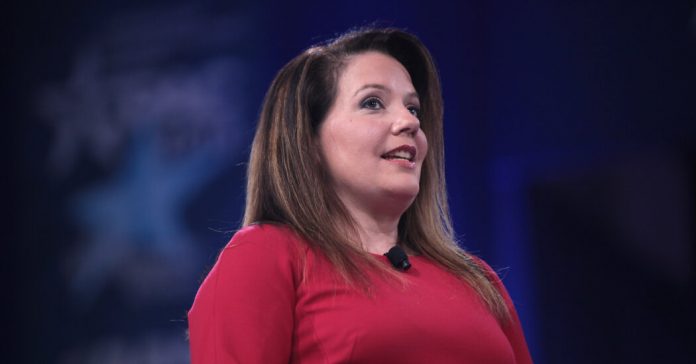
When President Trump ran for office four years ago, a conservative writer with a growing following vented the kind of doubt and cynicism that was common among people like her who worried about the damage he could do to their cause. She called him “a demagogue with no real solutions for anything at all.” She accused him of betraying the anti-abortion movement. And she wrote that his constant complaining about being treated unfairly was “ineffectual and impotent.”
Today, that writer, Mollie Hemingway, is one of Mr. Trump’s favorites. Her pieces for The Federalist, where she is a senior editor, have earned presidential retweets and affirmation for their scathing criticism of Democrats and the news media, whom she accuses of lying about just about everything when it comes to the president. Recently she claimed that journalists had fabricated reports about tear gas and the excessive use of force against protesters outside the White House (law enforcement, in fact, has acknowledged shooting a pepper-based irritant into the crowd), and said “a large group of Democrats” was defending the destruction of federal property (there is no such group).
Ms. Hemingway is part of a group of conservative commentators — who have large social media followings, successful podcasts and daily Fox News appearances — that has helped insulate the president and preserve his popularity with his base, even as many Americans say they are likely to vote against him in November.
What these writers and pundits don’t tend to do is make the doggedly pro-Trump defenses that appear on Breitbart and erupt from the mouth of Sean Hannity. Often, they don’t bother at all with the awkward business of trying to explain away Mr. Trump’s latest folly.
Instead, they offer an outlet for outrage against those the president has declared his enemies, often by reducing them to a culture war caricature of liberalism.
The capacity that many Trump supporters have developed to focus so intensely on the perceived wrongdoing of his opponents is a powerful asset for the president as he runs for re-election amid growing economic and social turmoil and a public health crisis that a majority of voters say they don’t trust him to handle. This almost entirely white cohort of conservative commentators can spend ample time mocking the mainstream and liberal media for focusing on Mr. Trump’s racist and divisive messaging without giving nearly as much consideration to the harm caused, for instance, when he promotes a video of someone shouting “white power.”
Through this lens, Mr. Trump’s transgressions seem irrelevant compared with the manifold misdeeds of everyone from the Clintons to CNN. Their portrayal of what the country would look like if the Democrats win big in November is indeed a frightening one to Trump supporters: a White House with Senator Bernie Sanders as the shadow socialist president; a Democratic House of Representatives where Representative Ilhan Omar calls the shots; a society in which mask mandates are the first step in a government experiment with social control; a political arena where conservatives are badgered into silence.
To many conservatives these scenarios seem perfectly plausible, especially as some prominent figures on the right contend that their voices are unwelcome in mainstream media — and even some liberals face a backlash for arguing that shaming and ostracism of opposing points of view has grown too common.
“There are a lot of conservatives reading ‘1984’ right now,” said Allie Beth Stuckey, who hosts a podcast, “Relatable” and is the author of a forthcoming book on self-esteem, “You’re Not Enough (And That’s OK).” Ms. Stuckey has a growing fan base and a large platform through her affiliations with right-leaning outfits like Turning Point USA and PragerU that are aimed at reaching millennials. While she does not go out of her way to defend the president, she said she got the sense from her audience that there are a lot of young women like her: socially conservative and religious, who sometimes cringe at Mr. Trump’s behavior but don’t let it bother them over all.
“There’s fear. It’s real fear. And I understand if you’re not a conservative it’s hard to be empathetic and it seems like an exaggeration,” Ms. Stuckey said. “But like the same kind of fear on the left that Trump is a unique threat to the country, there’s a real fear on the right, especially I would say from Christians, of what the country would look like under a Democratic president.”
The thread of commentary that isn’t explicitly pro-Trump as much as it is witheringly anti-left has blossomed into a big business, led by personalities like Ben Shapiro, the host of one of the most successful podcasts in the country and the author of best-selling books. His most recent is “How to Destroy America in Three Easy Steps,” in which he offers a stark take on how the “rising tide of radicalism from the left” threatens to tear the country apart.
Mr. Shapiro isn’t shy about calling out the president for his divisive and unfocused leadership. But far more often he takes shots at Mr. Trump’s critics. In this line of attack, Mr. Shapiro echoes other conservatives who deflect: Mr. Trump wasn’t helping anyone, for instance, by asking top public health officials to study whether disinfectant could be injected into the human body as a coronavirus treatment. But, Mr. Shapiro explained he didn’t actually tell people to put bleach in their bodies. “That doesn’t mean he was recommending actually injecting Clorox, people.”
Some media scholars see the desire to pick apart Mr. Trump’s critics as a form of entertainment disinformation. “They try to get you not to believe other kinds of information that you might hear in the larger media sphere, and it’s just fun,” said Khadijah White, a professor at Rutgers University who studies race, gender and the media. “It’s really fun to see the other side lose. And that just buttresses the idea that maybe Trump is corrupt, but they’re corrupt too.”
The anti-liberalism that is flourishing now can be traced back to other moments when the American left was resurgent and conservatives fought back, such as when Richard M. Nixon helped stoke a backlash of the “silent majority” to the antiwar and counterculture elements of society that many Americans believed had grown too extreme. But historians said this sentiment’s popularity today was a sign of how fragile unity is in a Republican Party led by a president who rejects many of the principles that conservatives have fought for over the last 40 years.
“The conservative ideology that had been cohesive during the Cold War is falling apart,” said Nicole Hemmer, a research scholar at Columbia University. “It seems to me that ‘owning the libs’ is kind of the way you hold everyone together when your policy preferences are coming apart.”
Undoubtedly The Federalist has been one of the biggest breakouts in this genre of commentary, diving headfirst into the culture wars. It debuted in 2013, inspired by what one of its founders, Ben Domenech, described as “a populist respect for the middle class reader outside of New York and Washington, and an abiding love for America.” It leans hard into the culture wars. Its pieces have questioned the Me Too movement (“One Year in, Me Too Hasn’t Made Me Feel Any Safer Or More Empowered To Speak Out”) and called the effort to recognize transgender identity a “war on women.”
The site’s sweet spot is with stories that feature conservatives battling liberal politicians and journalists in a clash where questions of privilege, gender and race reveal starkly different worldviews — like Justice Brett M. Kavanaugh’s confirmation or the boy from a Catholic high school in Kentucky who sued news outlets like CNN and The Washington Post for portraying him as mocking a Native American man and recently settled one of his defamation cases. (Ms. Hemingway, who wrote extensively about the Kavanaugh confirmation and co-authored a best-selling book on the hearings, did not respond to multiple requests for comment.)
The Federalist is often contrarian, sometimes to excess. Twitter briefly locked the site’s account in March after it shared an article with the headline “How Medical ‘Chickenpox Parties’ Could Turn The Tide Of The Wuhan Virus.” Publicly available web data for June shows that traffic for The Federalist is up 239 percent year over year, though the website’s internal numbers put the increase higher.
Critics have asked who is funding the site, since ad revenue alone wouldn’t be enough to sustain its staff of 14 and political websites often rely on wealthy donors for support. The Federalist has not disclosed its supporters, leading to criticism that it is not being transparent about its agenda. But according to two people with knowledge of its finances, one of its major backers is Dick Uihlein, the Midwestern packing supply magnate and Trump donor who has a history of giving to combative, hard-right candidates, like Roy S. Moore of Alabama, who make many Republicans squeamish. (After Mr. Moore was accused of assaulting underage girls in 2017, The Federalist ran an opinion piece that defended men who dated young women as a practice with a long history that was “not without some merit if one wants to raise a large family.”)
Through a spokesman, Mr. Uihlein declined to comment.
Tim Miller, a former strategist for Republican candidates, said that the combative tone of outlets like the Federalist was a sign of the way conservative commentary is defined today by “an unquenchable desire to take everybody else down a peg.”
Republicans who are no fans of Mr. Trump or the turn that their party has taken under him say that its fuming commentariat is a symptom of a deeper problem: its inability to govern. Though the G.O.P. controls half of Washington, its leading voices still often sound like the aggrieved opposition party.
“Ask them what they are building, and they can’t answer,” said Evan McMullin, who ran against Mr. Trump in 2016 as a third-party candidate. “They aren’t trying to build anything. They’re just tearing things down.”
This approach may not be enough to help Mr. Trump win again. Polls have shown that Democrats feel more intensity about voting than they did four years ago. And unlike in 2016, when exit polls found that voters who said they did not care for either presidential candidate broke overwhelmingly for Mr. Trump, former Vice President Joseph R. Biden Jr. has an edge with those voters now.
During the 2018 midterm elections, Republican candidates tried and largely failed with similar messaging, running ads that portrayed Democrats as socialists and radicals who would let drug gangs roam free on suburban streets. Republicans and the Trump campaign are pushing those themes again today, trying to use images of unrest from protests in Portland, Ore., and Seattle to paint a picture of lawlessness and disorder in Democratic-run cities. But there are signs that this messaging is out of step with the majority of Americans who support the overwhelmingly peaceful demonstrations nationwide against racism that followed the killing of George Floyd.
The subject of the protests — and the unrest in particular — is a frequent topic for Federalist writers like Ms. Hemingway. The other day she posted a query to her more than half a million Twitter followers: “I’m looking for videos of ‘peaceful protesters’ from the recent riots,” she wrote.
Mr. Trump was pleased. And he retweeted her.
The post These Conservatives Have a Laser Focus: ‘Owning the Libs’ appeared first on New York Times.







